Originally native to tropical and subtropical climates, Guava trees are hardy, aggressive perennials. Because it is inexpensive and full of nutrients, it is also known as the poor man’s apple. A Guava tree has a slender trunk with smooth bark that ranges from green to reddish brown. It may have branched trunks and drooping branches at the base.
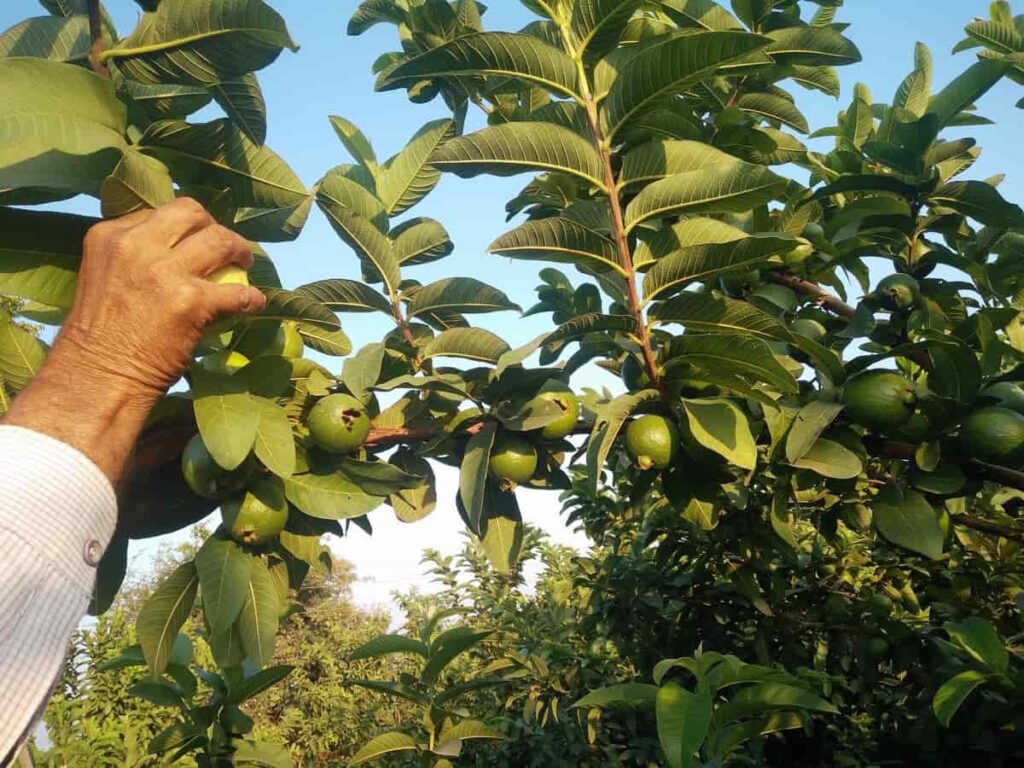
It has oval or elliptical leaves that are smooth on the upper surface and hairy on the lower surface. Guava produces solitary white flowers and berry fruits. It has an oval shape and a green-to-yellow color. Its flesh can be white, yellow, pink, or red and contains numerous yellowish seeds. The Guava tree grows up to 10 meters (33 feet) in height and lives for about 40 years.
How to control pests and diseases in Guava
Pests in Guava
The crop can be grown easily in all types of soil. However, Guava is affected by many pests. Hardy the Guava may be, but they have their share of Guava pest problems, most of which can be dealt with using natural pest control methods for Guava trees. Therefore, it’s essential to identify insects that attack Guava trees and fruit to incorporate Guava pest control.
Castor capsule borer
The adult is a medium-sized brownish-yellow colored moth with some dark spots on the wings. It lays eggs on the top leaf axils of young pseudostem. The larva bore into the tender parts of the panicle, flower buds, and immature capsules only. The later stage larva bore into the stem. The full-grown larva measures 15 to 25 mm long and pupates within the larval tunnel inside the pseudostems. The life cycle is completed within 25 to 40 days.
Disease symptoms
- Stem dries up as larva bores into it and then damages capsules.
- Caterpillars bore into young fruits, but they may also bore buds and tender shoots.
- It feeds on pulp and seeds found in internal contents
- Fruits infected with the disease dry up and fall off before ripening
- Fruits affected by larvae are generally deformed at the point of entry.
- It is possible to see larval feces exuding from the borer hole. Fruits of this type weaken, rot, and dropdown.
Biological control
- Collect and destroy the damaged plant parts.
- Use a light trap 1/ha to monitor the activity of adults.
- Release common predators of castor capsule borer such as ladybird beetle, reduviid bug, spider, red ant, robber fly, black drongo, common mynah, big-eyed bug, earwig, ground beetle, pentatomid bug and praying mantis, etc.
Chemical control
- Spraying the infested crop with endosulfan 35 EC 2.0 L or carbaryl 50 WP 2 kg or methyl parathion 50 EC 2.0 L at 1000-1200 liters of water per hectare proved effective in controlling the pest.
- Spray malathion 50 EC at 3 L or endosulfan 3 L or dimethoate 30 EC 3 L in 1500 – 2000 L water per ha, two rounds, one at flower formation and next at fruit set.
Bark-eating caterpillar
Adults are white with pairs of tiny black dots on the thorax, numerous small black spots and streaks on the fore wings, and few black spots on the posterior edges of hind wings. They lay eggs under loose bark or in cracks and crevices from April to June. It takes 8-11 days for eggs to hatch. The eggs are oval in shape and reddish in color. Caterpillars are pinkish-white with brown spots and are about 40mm long. The life cycle lasts 4-5 months in south India and more than a year in north India.
In case you missed it: How this Farmer Earning 60 Lakh Rupees from Thaiwan Pink Guava Cultivation
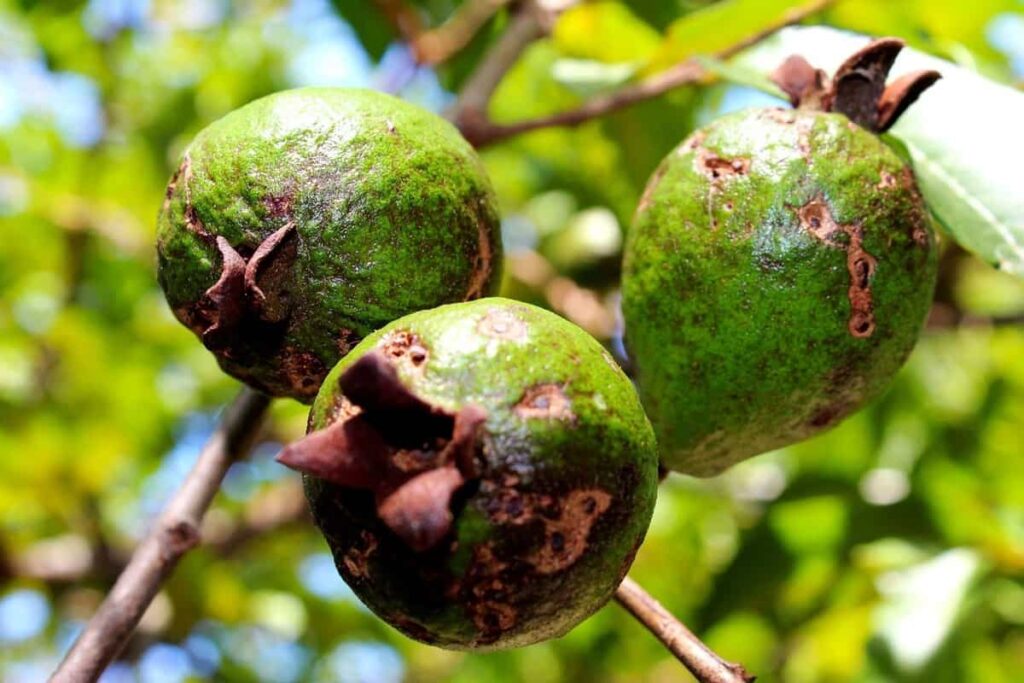
Disease symptoms
- The infestation of the pest may be identified by the presence of irregular tunnels and patches covered with a silken web consisting of excreta and chewed-up wood particles on the shoots, branches, stem, and main trunk.
- Holes on the trunk, Wood dust, and fecal matter hanging in the form of a web around the affected portion.
- Severe damage can result in the death of the attacked stem. The blackish larva can be observed underneath the fresh webbing.
- Branches and shoots may also have shelter holes at their joints.
- Young shoots die away, giving the plant a sickly appearance
Biological control
- Remove and destroy dead and severely affected branches of the tree
- Remove alternate host, silk cotton, and other hosts
- Scraping the loose bark to prevent oviposition by adult beetles.
- Hook out the grub from the borehole
Chemical control
- Sprays of 0.05% endosulfan, 0.05% trichlorfon, or 0.05% dichlorvos will kill the larvae at the nibbling stage from July onwards, and a fumigant soaked in cotton wool and sealed into the holes will control the larvae at the tunneling stage.
- Swab Coal tar + Kerosene @ 1:2 or Carbaryl 50 WP 20 g / lit of water on the basal portion of the trunk up to 3 feet height
- Padding with monocrotophos 36 WSC 10 ml in 2.5 cm /tree soaked in absorbent cotton.
- Apply the copper oxychloride paste on the tree’s trunk if severe infestations occur. After applying monocrotophos 36 WSC 10 to 20 ml/ hole
- Apply carbofuran 3G 5 g per hole and plug with mud.
Mealybug
Both nymphs and adult female insects suck the sap from tender leaves, shoots, inflorescence, and fruits. The severe infestation leads to wilting and affects fruit setting. In addition, mealybugs secrete honeydew which causes sooty mold. The infected leaves and inflorescence become shiny black, and sticky because of several fungi growing on this honeydew. Mealybugs are always associated with ants. The ants feed on honeydew and, in return, help mealybug spread to different parts of the plant.
Disease symptoms
- The tiny small bugs usually suck sap from twigs, leaves, and flowers.
- Infested fruits will have uneven shapes and poor quality and are susceptible to secondary infections by pathogens.
Biological control
- Release Australian lady bird beetle Cryptoleamus montrouzieri at 2500 to 3750 per hectare
- Conserve coccinellid Scymnus craccivora and lepidopteran predator Spalgis epius
- Spray with fish oil, rosin soap, neem oil, or basic soap spray to control Mealybugs. Then, add two tablespoons of liquid dish detergent or baby shampoo to 1 gallon of water.
- Also, soil application of the fungus spores, Beauveria bassiana, helps reduce the mealybug population.
Chemical control
- Debark the vines and swab with methyl parathion at 1 ml per liter to minimize the population
- Spray dichlorvos 1.0 L or chlorpyriphos 1.25 L or ibuprofen 25 SC 1.0-1.5 L or methomyl 40 SP 1.25 kg with 500 L water per hectare.
- Avoid spraying methyl parathion, carbaryl, methyldemeton, quinalphos, diazinon, malathion, etc., as they are toxic to predators.
Whitefly
There are a lot of problems in Guava cultivation, among which the Guava spiraling white fly has become a serious problem to Guava cultivation. Recently, it has been a common and major pest in Guava farming. Severe infestation of this pest may result in defoliation of the whole plant causing serious yield reduction of the fruit crop. Indirectly, the white fly causes a reduction of yield by transmitting viral pathogens and, through the secretion of wax and honeydew, reduces the photosynthetic areas of the plant.
In case you missed it: A Guide to Understand Guava Plant/Tree Propagation: Check How this Guide Helps Guava Farmers
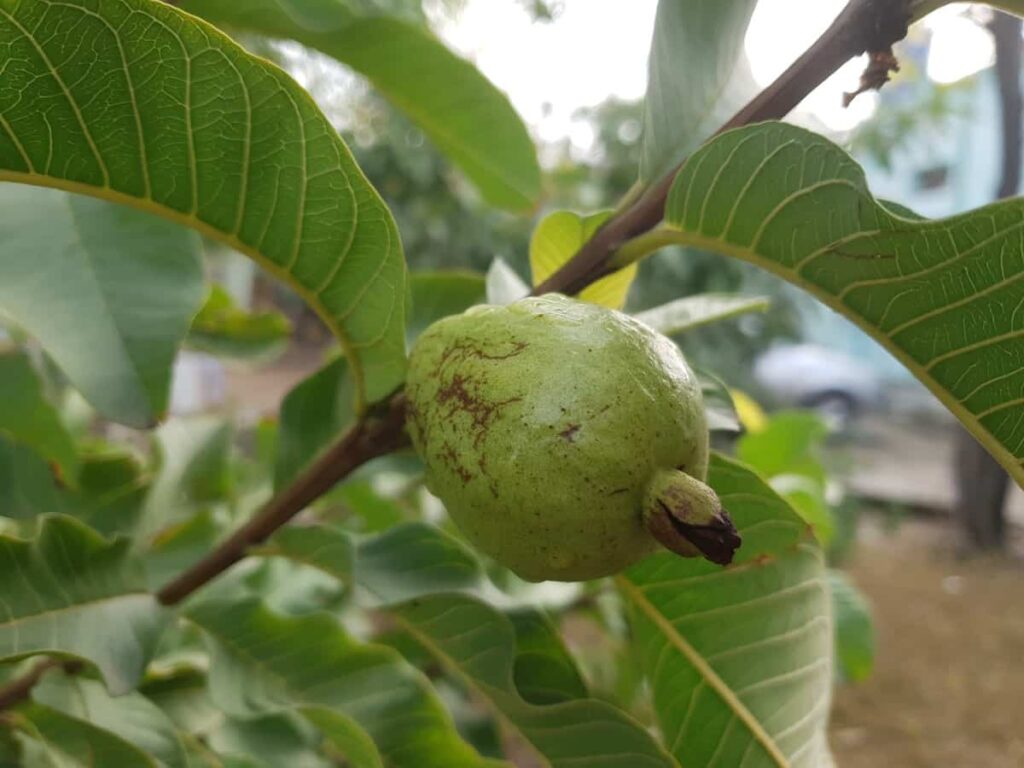
Disease symptoms
- Adults and nymphs congregate heavily on the lower surface of the leaf, suck the sap and cause premature leaf drop, chlorosis, yellow speckling, crinkling, and curling.
- Honeydew secretion also leads to the development of sooty mold fungus.
- The copious white, waxy, flocculent material secreted by all the stages of the pest is readily spread by wind.
Biological control
- Remove and destroy damaged leaves along with life stages.
- Remove and destroy weed plants like Abutilon, Acalypha, Euphorbia, etc., in the nearby vicinity, as these plants are alternate hosts.
- Use yellow sticky traps at 15/ha to attract and kill the adults
- Release Chrysoperla Carnea predators at 10000 per hectare to destroy all life stages
- Encourage the activity of predators such as Encarsia and Coccinellids, Chilocorus nigrita, etc.
Chemical control
- Spray Fish oil rosin soap (FORS) 25g/L or NSKE 5% or neem oil 0.03% 1ml/l or phosalone 35 EC 3 L or triazophos 40 EC 3 L or acephate 75 SP 1.5 kg in 1500 -2000 L per ha., two to three times based on the incidence.
- Avoid using synthetic pyrethroids and extending crop growth.
- Conserve spiraling whitefly parasitoids, Encarsia haitiensis and E. guadeloupae.
Aphids
Guavas are sometimes inhabited by aphids, which leave behind sticky residues or honeydew. Ants are attracted to this honeydew. Aphids and scale insects are protected from predators by ants, who move them around, increasing their numbers. Pruning branches that touch buildings or other plants that act as a bridge to the tree can help prevent ants from nesting there.
Disease symptoms
- The symptoms include curling, stunting, or yellowing leaves. In addition, aphids love to hide on the undersides of leaves.
- It might indicate aphid infestation if a sticky substance appears on the leaves or stems. Additionally, honeydew can attract other insects, such as ants.
- Honeydew can develop a fungal growth called sooty mold, which causes branches and leaves to appear black.
- Aphids feeding on flowers or fruit can cause them to deform.
Biological control
- Wrap sticky tape around the tree’s trunk. Around the base of the tree, bait traps can also be placed.
- Spray cold water on the leaves to dislodge these pesky pests.
- Dust the plants with flour as it constipates the pests and prevents rapid reproduction.
- Use insecticidal soap or horticultural oil to spray the plant.
Chemical control
- BotaniGard 22WP should be applied to the affected crop area to control ongoing aphid issues.
- Chlorpyrifos, Monocrotophos 36% SL, Dimetholate, Imidacloprid 17.8% SL, and Beta-cyfluthrin 10.5% also effectively control aphids in Guava.
Diseases in Guava cultivation
Many pathogens, mainly fungi, affect the Guava crop. About 91 pathogens are reported on fruits, 42 on foliage, 18 on twigs, and 18 on roots. These cause various diseases, viz. pre and post-harvest rots of fruits, canker, wilt, die-back, defoliation, twig drying, leaf spot, leaf blight, anthracnose, red rust, sooty mold, rust, seedling blight and damping off, etc. Some important diseases of Guava and different measures for their effective management are discussed below, regarding past and present developments.
In case you missed it: A Step-By-Step Guide to High Density Fruit Farming: For Guava, Banana, Mango, Pineapple, Lemon, Papaya, Litchi, and Apple
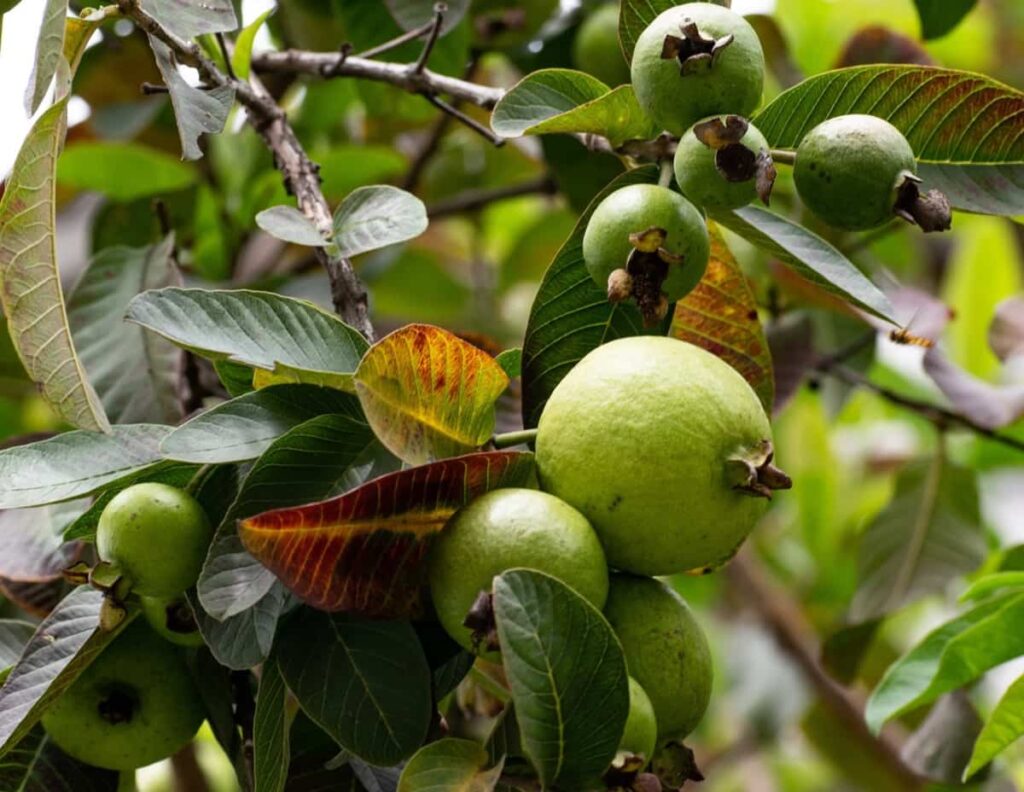
Guava wilt
Guava wilt is a dramatic and devastating disease of plants that usually becomes noticeable with the onset of the rainy season. The plant may develop light yellow leaves and sag noticeably, prematurely shed fruits, or defoliate entirely. Unfortunately, plants have no cure for wilt infections, but good nutrition, including heavy nitrogen feedings after fruiting and protecting roots from damage, can help stave off the disease.
Disease symptoms:
- In the monsoon season, light yellow foliage appears with loss of turgidity and epinasty.
- In a later stage, plants show unthriftiness, resulting in premature shedding and defoliation.
- The twigs of some trees become bare and fail to produce new leaves or flowers, eventually drying up. In addition, there are no fruits on any affected branches because they are underdeveloped, hard, and stony. Eventually, the whole plant dies from defoliation.
- The roots also rot at the basal region, and the bark is easily detachable from the cortex. The light brown discoloration is also noticed in vascular tissues.
Chemical control and management
- Different workers have used many chemicals like Chaubatia paste, Water soluble 8-Quinolphos sulfate, Benlate or Bavistin, Metasystox and Zinc sulfate, Thiopanate methyl, Captafol, and Thiobendazoles.
- Besides fungicides, some soil amendments, chemicals/cakes/fertilizers were also effective against wilt. Oil cakes like neem cake, mahua cake, and Kusum cake supplemented with urea at 10 kg and 1kg, respectively, also manage the disease.
- The infection can be minimized by soil drenching with Brasicol and spraying Bavistin (0.1%) around the roots and leaves for 15 days.
- The disease could be controlled by proper sanitation in the orchard.
- Wilted trees should be uprooted and burnt, and a trench should be dug around the tree trunk.
Fruit rot
The disease is Prevalent in the wet-rainy season (from July to September). The fruits hanging near the ground or with dense foliage lacking proper ventilation are mostly affected. The disease also appears during storage. Cool, wet environmental conditions with high moisture in the soil favor disease development.
Disease symptoms
- The symptom starts at the calyx disc of the fruit during the rainy season.
- The affected area is covered with whitish cotton-like growth, which develops quickly as the fruit matures. The pathogen can cover almost the entire surface within 3-4 days during humid weather.
- Fruits covered with dense foliage near the soil level are most severely affected by high relative humidity. Furthermore, fallen fruits are badly damaged.
- Light brown to dark brown becomes the color of the fruit’s skin below the whitish cottony growth
Chemical and control management
- Copper oxychloride inhibits the conidial germination of the pathogen. However, it is reported to be toxic for the Guava fruit.
- Dithane Z-78 (2 grams. per liter) or Ridomil or Aliette (2 grams), or Copper oxychloride (3 grams.) is found effective in controlling the foliar infection.
- Soil drenching with Copper oxychloride (3 grams.) or Ridomil or Aliette (2 grams.)
- Plant spacing and canopy of the plant should be managed to avoid unnecessarily dense plant canopy
In case you missed it: Fertilizer Management in Guava Trees – Organic, Liquid, Natural, NPK, and Homemade
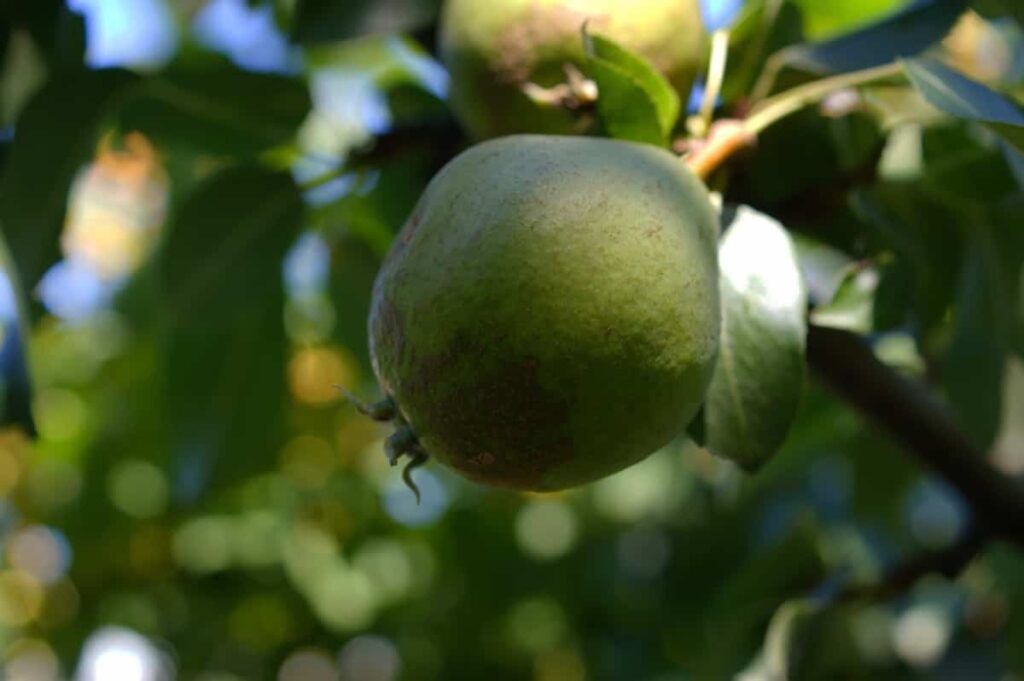
Stem canker and dry fruit rot
The fungus causes the disease, and the primary source of inoculum is dormant mycelium. A quick attack of the fungus causes fruit damage. The infection can be spread secondarily by wind-borne conidia, water splash, proximity to infected plants, injury, and transportation of infected leaves. The fungus can grow in humid environments between 20 and 25°C with a dense canopy and insufficient airflow.
Disease symptoms
- Pathogen attack main branches and stems, which causes the cracking of lesions
- Affected branches wilt as the stem tissues are killed. In addition, fungal perithecia, small brown to black structures, may develop on the infected stem.
- On fruit, disease symptoms appear as light brown spots, generally at the stalk or calyx end.
- Within four days, the fruit becomes dark brown to black and mummified.
- Twin-bearing, infected fruits show and die back.
Chemical control and management:
- The disease can be controlled in severe infection by removing and destroying the infected stem.
- Copper sulfate and two parts each of lime and linseed oil or Chaubatia paste (copper carbonate – 800 g, red lead – 800 and linseed oil – 1 liter.
- Spraying the trees with copper oxychloride (0.2 percent)
- The spread of disease in the early stage of infection is controlled by 3 to 4 sprays of 1 percent Bordeaux mixture or lime sulfur at 15 days interval
- Using foam net while bagging fruits will prevent injury to the fruit and hence canker
Algal leaf and fruit spot
A variety of parasitic algae may infect your Guava if you notice rusty or brown spots during humid weather. The Algal leaf spot is relatively harmless to the plant and the fruit, but severe infections can reduce vigor, decreasing the plant’s ability to produce fruit. Therefore, it is best to reduce the humidity around your plant, including pruning it, as much as possible.
Disease symptoms
- Several minute, shallow brown velvety lesions appear on leaves, especially near the midvein, and as the disease progresses, the lesions grow to 2-3 mm in diameter.
- On leaves, the spots may vary from specks to big patches, which may be crowded or scattered.
- The lesions are nearly black on immature fruits. Lesions on older blemishes become sunken and cracked as they enlarge. Due to the enlargement of fruits, lesions are usually smaller than leaf spots. Their color ranges from dark green to brown or black
In case you missed it: Guava Pests, Diseases, and Control, Guava Plant Care
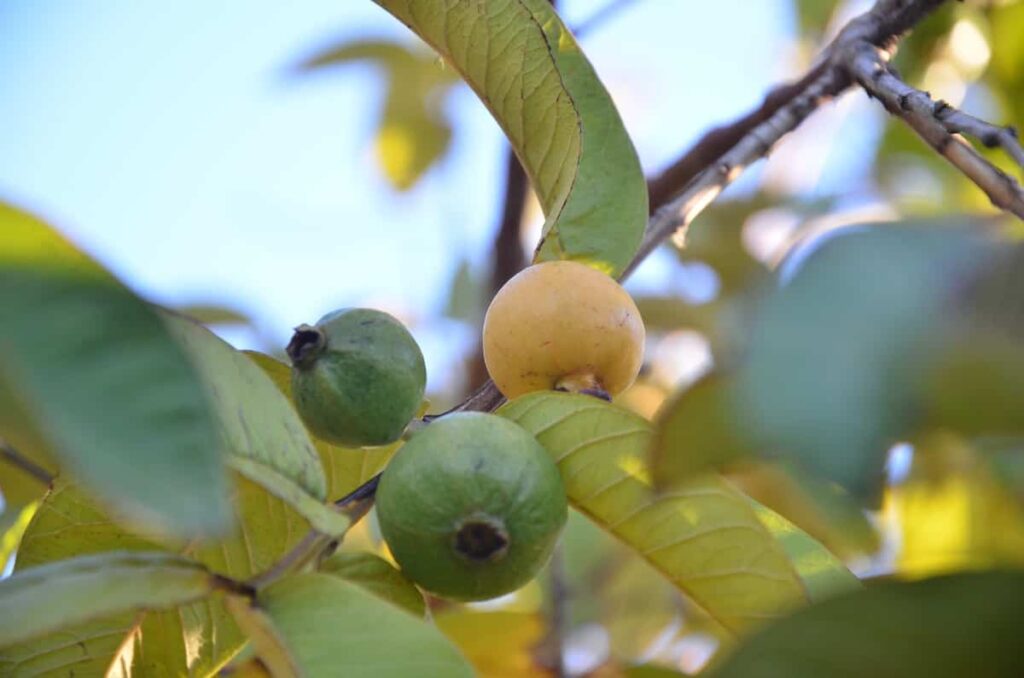
Chemical control and management
- Algal leaf spots can be reduced by maintaining tree vigor with artistic techniques such as proper fertilization and irrigation, adequate pruning to enhance air circulation within the canopy and sunlight penetration, managing weeds, and wider tree spacing.
- Managing insect, mite, and other foliar diseases increases tree vigor and lessen susceptibility to this disease.
- Spray Copper oxychloride 0.25%.
Conclusion
Using agrochemicals to control pests and diseases has become a pragmatic approach to pest and disease management. However, overuse and indiscriminate application of insecticides and fungicides in Guava have resulted in tolerance to insecticides and fungicides, pest resurgence, accumulation of harmful residues, and toxicity to non-target organisms.
- Economical Aquaculture: A Guide to Low-Budget Fish Farming
- 15 Common Planting Errors That Can Doom Your Fruit Trees
- How to Make Houseplants Bushy: Effective Tips and Ideas
- Innovative Strategies for Boosting Coconut Pollination and Yield
- Pollination Strategies for Maximum Pumpkin Yield
- The Complete Guide to Chicken Fattening: Strategies for Maximum Growth
- Natural Solutions for Tulip Problems: 100% Effective Remedies for Leaf and Bulb-Related Issues
- Revolutionizing Citrus Preservation: Towards a Healthier, Greener Future
- Natural Solutions for Peony Leaf and Flower Problems: 100% Effective Remedies
- Maximizing Profits with Avocado Contract Farming in India: A Comprehensive Guide
- Natural Solutions for Hydrangea Problems: 100% Effective Remedies for Leaf and Flowers
- The Ultimate Guide to Choosing the Perfect Foliage Friend: Bringing Life Indoors
- From Sunlight to Sustainability: 15 Ways to Use Solar Technology in Agriculture
- The Ultimate Guide to Dong Tao Chicken: Exploring from History to Raising
- The Eco-Friendly Makeover: How to Convert Your Unused Swimming Pool into a Fish Pond
- Mastering the Art of Delaware Chicken Farming: Essentials for Healthy Backyard Flocks
- 20 Best Homemade Fertilizers for Money Plant: DIY Recipes and Application Methods
- How to Craft a Comprehensive Free-Range Chicken Farming Business Plan
- Brighten Your Flock: Raising Easter Egger Chickens for Beauty and Bounty
- How to Optimize Your Poultry Egg Farm Business Plan with These Strategies
- Subsidy for Spirulina Cultivation: How Indian Government Schemes Encouraging Spirulina Farmers
- Ultimate Guide to Raising Dominique Chickens: Breeding, Feeding, Egg-Production, and Care
- Mastering the Art of Raising Jersey Giant Chickens: Care, Feeding, and More
- Ultimate Guide to Raising Legbar Chickens: Breeding, Farming Practices, Diet, Egg-Production
- How to Raise Welsummer Chickens: A Comprehensive Guide for Beginners
- How to Protect Indoor Plants in Winter: A Comprehensive Guide
- Ultimate Guide to Grow Bag Gardening: Tips, Tricks, and Planting Ideas for Urban Gardeners
- Guide to Lotus Cultivation: How to Propagate, Plant, Grow, Care, Cost, and Profit
- Agriculture Drone Subsidy Scheme: Government Kisan Subsidy, License, and How to Apply Online
- Ultimate Guide to Raising Araucana Chickens: Breed Profile, Farming Economics, Diet, and Care
- Bringing Hydroponics to Classroom: Importance, Benefits of Learning for School Students
- Ultimate Guide to Raising Polish Chickens: Breed Profile, Farming Economics, Diet, and Care
- Ultimate Guide to Raising Australorp Chickens: Profile, Farming Economics, Egg Production, Diet, and Care
- Silkie Chicken Farming: Raising Practices, Varieties, Egg Production, Diet, and Care
- Sussex Chicken Farming: Raising Practices, Varieties, Egg Production, Diet and Care
- Homemade Feed Formulations for Livestock: Discover Cost-effective Starter to Finisher Feed Recipes
Much thanks the written document i saw in this of about guava disease and pest contro, it can help really i think affordable to any and can be also applicable to control guava pest on general.
Thanks